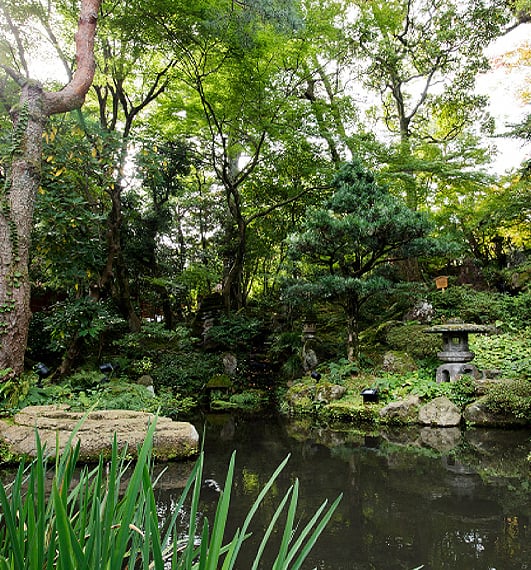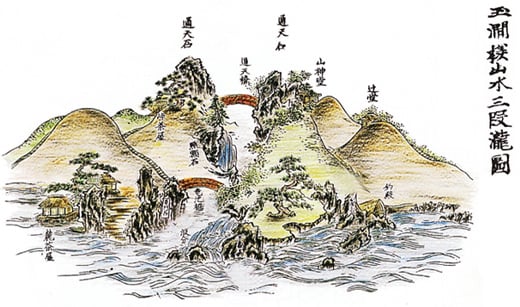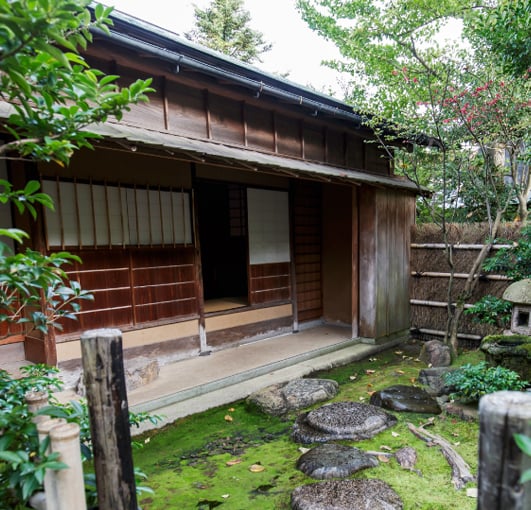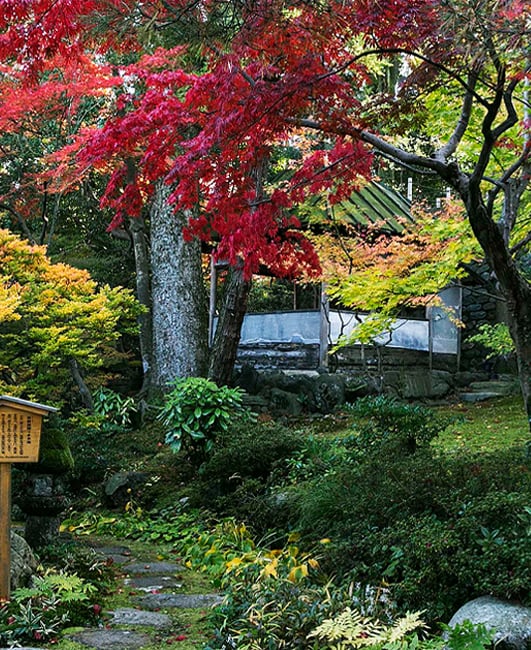A garden with a 400-year history,
associated with the Kaga clan
Gyokusen-en Garden, which is located close to Kenrokuen Garden, has 400 years of history.
The garden was landscaped by the Wakita family, senior retainers of the Kaga clan, over a period of about 100 years. The landscaping was started by Wakita Naokata in the early Edo period, and completed by the fourth-generation Kyubei.
The name of the garden, “Gyokusen-en,” was derived from the name of Gyokusen-in, the lawful wife of the second lord of the Kaga clan, Maeda Toshinaga. Gyokusen-in made it possible for Naokata to marry the daughter of the Wakita family.
Gyokusen-en Garden borrows the landscape of Kenroku-en Garden and draws pond water from the stream near the Kotoji lantern of Kenroku-en Garden. These connections reflect the strong ties that existed between the Kaga clan and the Wakita family.
After the Wakita family left Kanazawa in the early Meiji period, the Nishida family inherited the garden.
The spacious 2,370 m2 garden boasts giant trees that existed even before the landscaping was carried out. An ancient Korean pine tree and a Chinese trumpet creeper have witnessed the garden's transformations.
In 1960, the garden was designated as a place of scenic beauty by the prefecture.

One of only six fantastic Gyokkan-style gardens in Japan
This is a Japanese-style garden with two levels of paths around a central pond, featuring a beautiful undulating landscape. The garden is said to have been designed based on a landscape picture.
The picture was drawn by the artist-monk Gyokkan. One of three pictures at the end of the book Kokin Tea Ceremony Complete Book, 5th volume, “Gyokkan-style landscape with three-tiered waterfall garden,” is very similar to the cliff area centered on the east waterfall of Gyokusen-en Garden. The date of publication of the book coincides with the time when the third-generation Naonaga was landscaping the garden.
Gyokkan-style gardens are named after the artist-monk Gyokkan, and are said to be fantastic gardens; there are only six of them in Japan. Gyokusen-en Garden is the only one on the Sea of Japan side of the country. The picturesque garden invites visitors to the paradise depicted by an ancient priest.

Features of the Gyokkan-style garden
-
Two man-made hills
-
A waterfall between two hills
-
A stone bridge above the waterfall
-
A cave above the stone bridge
Gyokusen-en Garden has all of these four features.

The oldest tea-ceremony house in Kanazawa Saisetsu-tei Alley
Senso Soshitsu, founder of the Urasenke school of tea ceremony, was invited to Kanazawa by the fifth lord Maeda Tsunanori, and appointed magistrate for the administration of tea ceremony utensils, while living near Kanazawa Castle.
Naoyoshi, a second-generation member of the Wakita family, is said to have studied the tea ceremony under Senso Soshitsu.
Saisetsu-tei Alley, on the upper level of the garden, was built according to the directions of Senso Soshitsu, where there is a garden centered on the pond and the Saisetsu-tetei tea ceremony house. In the front garden of the teahouse, there is a washbasin with a raised carving of a flying dragon.
Saisetsu-tei, which has an area of one tatami mat and two daime-tatami mats, is a teahouse featuring simplicity and quietude. It is said to be the oldest teahouse in Kanazawa.

A garden landscaped by four generations of the Wakita family
The landscaping was carried out from the early to mid Edo period.
The first-generation Naokata was born in Kanjo, Korea; his childhood name was Kim Yochol.
When Toyotomi Hideyoshi sent an army to Korea to wage the Seikan battle, Yochol’s father Kim Shihshon died and the boy became an orphan.He was taken to Japan by Ukita Hideie, a military commander.
Hideie was banished to Hachijo-jima island after losing the battle of Sekigahara. Kim Yochol was sent to live in Kanazawa Castle with Gohime, the fourth daughter of Maeda Toshiie, the first lord of the Kaga clan. He was raised by Oei, the lawful wife of the second Lord Toshinaga (who became Gyokusen-in after retirement). When he grew up, he became one of Toshinaga’s retainers and he was naturalized. Then he married Wakita Shigetoshi’s daughter, and changed his name to Wakita Naokatsu, becoming a first-generation member of the Wakita family.
The second-generation Naoyoshi studied under Kinoshita Jun-an and learned the tea ceremony from Senso Soshitsu. The third-generation Naonaga was an expert performer of the tea ceremony called Yu-an.
The landscaping of Gyokusen-en Garden was started by the first-generation Naokata and completed by the fourth-generation Kyubei.
Subsequently, the fifth Naoyasu, sixth Naoharu and seventh Naotomo headed the Wakita family.
The Meiji Restoration occurred in 1868 during the period of the seventh generation.
The Wakita family left Kanazawa in 1878, and the Nishida family inherited the house and garden in 1905.
